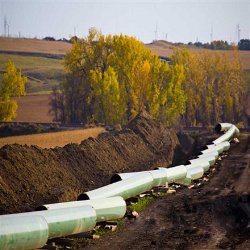The suburban town of Mayflower, Arkansas is making waves in the headlines after an Exxon Mobil Corp. (NYSE: XOM) pipeline burst last Friday.
The Exxon response team has gathered 12,000 barrels of oil since last reported and the flow was stopped early Saturday morning. The U.S. Environmental Protection Agency is classifying the incident as a major spill, and the Mayflower Unified Command Center, which includes Exxon, Faulkner County, and the city of Mayflower, estimated early on that the spill was roughly a few thousand barrels; Exxon hasn’t released its official count.
Exxon has located the rupture and is now awaiting the go ahead by the Department of Transportation to begin excavation and repairs, but the company has no set timeline in place for now.
The incident gives President Obama a thing or two to think about while the U.S. State Department reviews plans for TransCanada Corp.’s (NYSE: TRP) proposed Keystone XL pipeline project – a pipeline criticized as more hazardous than the Pegasus pipeline that ruptured in Arkansas.
 The Pegasus is a 20 inch pipeline that runs from Nederland, Texas all the way to Patoka, Illinois. It can carry 96,000 barrels a day of diluted bitumen, or dilbit, reports Bloomberg –not nearly the proposed capacity Keystone could reach.
The Pegasus is a 20 inch pipeline that runs from Nederland, Texas all the way to Patoka, Illinois. It can carry 96,000 barrels a day of diluted bitumen, or dilbit, reports Bloomberg –not nearly the proposed capacity Keystone could reach.
Keystone XL
The Keystone project would link Alberta, Canada’s oil sands with refineries along the U.S. Gulf Coast, further strengthening the bond the two nations share, as already, according to CTV News, 99 percent of Canada’s crude oil exports and 100 percent of gas exports are supplied to the U.S.
Critics say the type of fuel that would pass through the keystone pipeline – dilbit – is more corrosive than conventional forms of oil, potentially making it that much more of a threat to the environment and creating the risk of future incidents like the one in Arkansas.
The fuel has a gritty, thick, and heavy consistency, much more than forms of conventional crude oil. Because of that, it is a lot tougher to clean up.
If it finds itself in bodies of water, it’s extremely hard to recover. It doesn’t stay at the surface where it can be cleaned more effectively, but instead sinks to the bottom, creating a much larger mess.
Environmentalists are quick to point this out.
Last week’s incident occurs a little more than a year after the President signed a bill into law that would strengthen pipeline-safety regulations. The Pipeline Safety Act authorizes the Hazardous Materials Safety Administration (PHMSA) as part of the Transportation Department to impose strict fines and regulations that pipeline operators must adhere to.
Until further investigation into the matter is conducted, it is uncertain if this spill could have been prevented as a part of the newly enacted law.
Despite concern, the Keystone would generate thousands of jobs and further strengthen U.S. energy security. Both sides of Congress see the upswing of such a venture, and on March 22, according to Bloomberg, a non-binding resolution to encourage Keystone development was approved 62-37. If the project does get off the ground, it will carry more than 800,000 barrels of dilbit a day.
Our analysts have traveled the world over, dedicated to finding the best and most profitable investments in the global energy markets. All you have to do to join our Energy and Capital investment community is sign up for the daily newsletter below.
Safety Precautions
TransCanada is on board with higher safety standards and has promised to include more shutoff valves, monitored inspections, and even bury the pipe deeper in the ground – whatever it takes to make the Keystone project a safe and successful joint venture with the U.S.
Last month, the National Wildlife Federation directly pleaded with the U.S. to develop environmentally friendly standards for transporting tar-sands oil, a clear indication that given the proper dedication to safety and health standards, a modernized pipeline can benefit our nation’s economy and be environmentally conscious at the same time.
There is no doubt that the Arkansas spill, like any other oil spill in the past, is unfortunate and can even escalate into a tragedy if not handled properly. But with knowledge, environmental awareness, and modernized pipeline techniques, the management and care of such an undertaking like Keystone would bring great benefits.
As CTV News reports, Canadian Natural Resources Minister Joe Oliver said:
“Global energy demand is expected to increase by over 36 per cent from 2010 to 2035 and Canada is well positioned to support that demand,” Oliver told reporters in Ottawa. “But without the infrastructure to move the product to market, our oil will be stranded and our legacy lost.”
The proposed pipeline is a significant strategic move for both sides of the border.
At this time, a complete study is being done on the impact of a heavier type of oil, or dilbit, and the effect it will have on pipelines, as required by the Pipeline Safety Act. The report, which is expected to conclude in June, will most likely be the deciding factor in President Obama’s decision on the Keystone pipeline.
When White House press secretary Jay Carney was asked if the spill would affect the President’s decision, according to National Journal, he replied that the two had not discussed it, and no other details were given.
If you liked this article, you may also enjoy:




